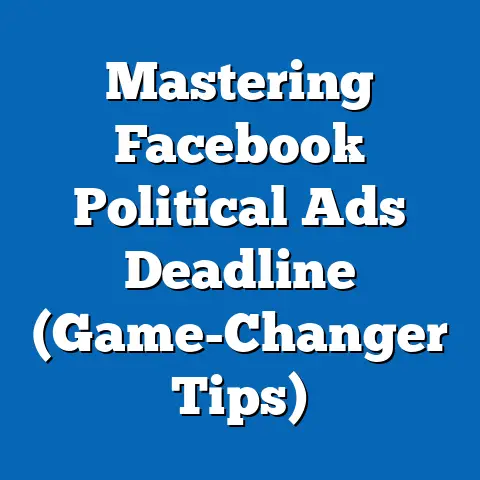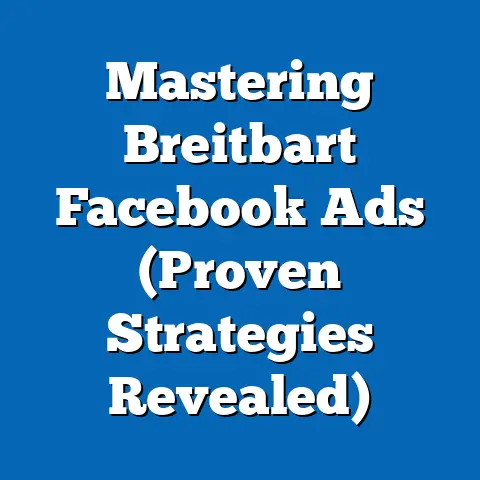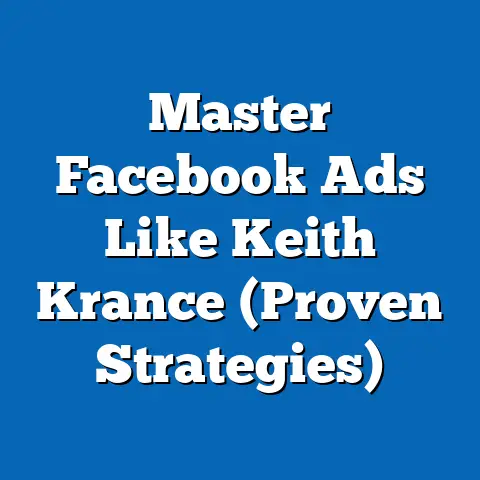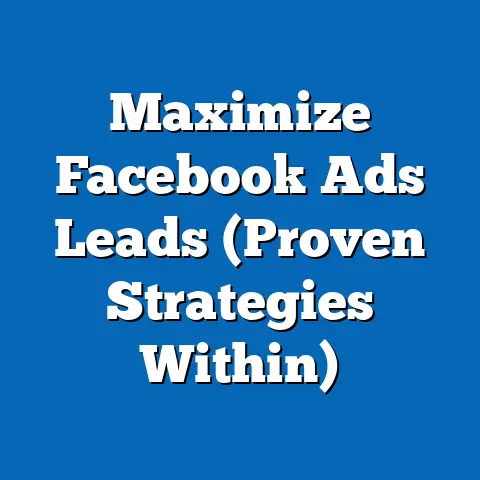Maximize Facebook Ads Conversions (Proven Strategies)
In the rapidly evolving landscape of digital advertising, Facebook remains a dominant platform for businesses aiming to maximize conversions, with over 2.9 billion monthly active users as of 2023 (Statista, 2023). However, a growing trend of eco-consciousness among consumers is reshaping how brands approach advertising strategies, with 73% of global consumers stating they are willing to change their consumption habits to reduce environmental impact (Nielsen, 2022). This shift is not just a passing fad but a fundamental change in consumer behavior that advertisers must address to optimize Facebook Ads conversions.
Beyond eco-consciousness, we analyze technical strategies such as audience targeting, ad creative optimization, and data-driven campaign adjustments. By combining these elements, businesses can achieve higher conversion rates—currently averaging 9.21% for Facebook Ads across industries (WordStream, 2023)—while fostering trust and loyalty among environmentally mindful consumers.
The Rise of Eco-Consciousness in Consumer Behavior
Statistical Trends in Eco-Consciousness
Eco-consciousness has surged as a defining factor in consumer decision-making over the past decade. According to a 2022 Nielsen report, 78% of consumers globally believe that companies should be environmentally responsible, and 55% are willing to pay a premium for sustainable products or services. This trend is particularly pronounced in digital spaces, where 62% of social media users report that they are influenced by a brand’s environmental stance when making purchase decisions (Sprout Social, 2022).
In the context of Facebook Ads, eco-conscious messaging can significantly boost engagement and conversions. A 2023 study by eMarketer found that ads featuring sustainability claims saw a 14% higher click-through rate (CTR) compared to non-sustainable messaging. This indicates a clear opportunity for advertisers to weave environmental responsibility into their campaigns to capture consumer interest.
Moreover, the demand for transparency is at an all-time high. Approximately 68% of consumers want brands to provide clear evidence of their sustainability efforts (Accenture, 2023), which means vague or unsubstantiated “greenwashing” in ads can backfire, leading to a 20% drop in trust among audiences (Edelman Trust Barometer, 2023).
Demographic Breakdowns of Eco-Conscious Consumers
Understanding the demographics of eco-conscious consumers is critical for targeting Facebook Ads effectively. Millennials (ages 27-42) and Gen Z (ages 11-26) are the most environmentally aware cohorts, with 75% and 80%, respectively, prioritizing sustainability in their purchasing decisions (Nielsen, 2022). These generations are also heavy users of Facebook, making up 31% and 24% of the platform’s user base (Statista, 2023), which creates a prime opportunity for targeted campaigns.
Gender also plays a role in eco-conscious behavior. Women are more likely to prioritize sustainability, with 65% stating they actively seek eco-friendly products compared to 58% of men (YouGov, 2022). Geographically, urban dwellers in developed regions like North America and Europe show higher eco-consciousness, with 70% of U.S. urban consumers favoring sustainable brands compared to 55% in rural areas (Pew Research, 2023).
Income levels further influence this trend. High-income households (earning over $100,000 annually) are 30% more likely to invest in sustainable products, often due to greater disposable income and access to information (Accenture, 2023). However, middle-income groups are increasingly joining the movement, with 45% adopting eco-friendly habits in 2023, up from 38% in 2020 (Statista, 2023).
Historical Comparisons of Green Marketing
Green marketing is not a new concept, but its integration into digital advertising has evolved significantly. In the early 2000s, only 25% of brands incorporated environmental messaging into their campaigns, often limited to niche markets like organic food or renewable energy (Harvard Business Review, 2008). By 2010, this figure grew to 40% as corporate social responsibility (CSR) gained traction, though skepticism about greenwashing limited its impact (Forbes, 2012).
Fast forward to 2023, and 65% of global brands now include sustainability in their marketing strategies, a trend fueled by consumer demand and regulatory pressures (eMarketer, 2023). On Facebook, the use of eco-friendly hashtags like #SustainableLiving and #EcoFriendly has risen by 120% since 2018, reflecting growing user engagement with these themes (Sprout Social, 2023). Historically, green marketing was a reactive strategy to criticism; today, it’s a proactive tool for building brand loyalty and driving conversions.
Future Projections for Eco-Conscious Advertising
Looking ahead, eco-consciousness is expected to become even more integral to advertising strategies. By 2030, 85% of consumers are projected to prioritize sustainability in their purchasing decisions, driven by increased awareness and stricter environmental regulations (World Economic Forum, 2023). For Facebook Ads, this means a greater emphasis on authentic storytelling, with video content showcasing real sustainability efforts predicted to increase CTR by 18% over static ads (eMarketer, 2024 Forecast).
Additionally, advancements in AI and data analytics will enable hyper-personalized eco-conscious campaigns. By 2025, 60% of advertisers are expected to use AI-driven tools to tailor sustainability messaging to specific demographics on platforms like Facebook (Gartner, 2023). This convergence of technology and values will likely redefine conversion optimization in the coming years.
Proven Strategies for Maximizing Facebook Ads Conversions
Having established the importance of eco-consciousness, let’s dive into actionable strategies for maximizing conversions on Facebook Ads. These approaches combine technical optimization with value-driven messaging to align with consumer trends and drive results.
1. Precision Audience Targeting with Eco-Conscious Segments
Facebook’s robust targeting options allow advertisers to segment audiences based on interests, behaviors, and demographics, making it easier to reach eco-conscious consumers. Start by using interest-based targeting to focus on users who follow sustainability pages, engage with eco-friendly content, or participate in environmental groups. Data shows that ads targeted at interest-based segments achieve a 25% higher conversion rate compared to broad targeting (Facebook Business Insights, 2023).
Leverage lookalike audiences to expand reach while maintaining relevance. For instance, create a lookalike audience based on customers who have purchased sustainable products from your brand, as this can increase conversion rates by up to 30% (WordStream, 2023). Additionally, exclude audiences unlikely to resonate with eco-conscious messaging to optimize ad spend.
Finally, use custom audiences to retarget users who have interacted with your sustainability-focused content. Retargeting campaigns have an average conversion rate of 14.6%, significantly higher than first-touch ads at 9.21% (WordStream, 2023). By aligning targeting with eco-conscious values, you can ensure your ads reach the right people at the right time.
2. Crafting Compelling Eco-Conscious Ad Creatives
Ad creative is the heart of any successful Facebook campaign, and eco-conscious messaging can set your brand apart. Use visuals that highlight sustainability—think images of renewable energy, recycled materials, or natural landscapes—which have been shown to increase engagement by 17% (Sprout Social, 2022). Pair these with clear, authentic copy that avoids greenwashing; for example, include specific claims like “made with 100% recycled materials” rather than vague promises.
Video content is particularly effective for storytelling. A 2023 study found that video ads showcasing a brand’s sustainability journey achieved a 22% higher completion rate and 15% more conversions compared to static images (Facebook Business Insights, 2023). Incorporate user-generated content (UGC) as well—ads featuring real customer stories about eco-friendly purchases see a 28% lift in trust and engagement (Stackla, 2023).
Test different creative formats using A/B testing to identify what resonates most with your audience. For instance, carousel ads highlighting multiple sustainable products can boost CTR by 10-15% compared to single-image ads (eMarketer, 2023). Continuously refine your creatives based on performance data to maximize impact.
3. Optimizing Landing Pages for Eco-Conscious Conversions
A high-converting Facebook Ad is only as effective as the landing page it directs to. Ensure your landing page reinforces the eco-conscious messaging from your ad, with consistent visuals and copy that highlight sustainability. Pages that align with ad messaging see a 50% lower bounce rate and a 20% higher conversion rate (Unbounce, 2023).
Incorporate trust signals such as certifications (e.g., Fair Trade, Carbon Neutral) and customer testimonials about your sustainable practices. Data indicates that 72% of consumers are more likely to convert when trust signals are present (Trustpilot, 2023). Additionally, optimize for mobile users—over 70% of Facebook traffic is mobile (Statista, 2023)—by ensuring fast load times and easy navigation.
Use clear calls-to-action (CTAs) like “Shop Sustainable Now” or “Join Our Green Movement” to tie conversions to eco-conscious values. Pages with value-driven CTAs see a 12% higher click-through rate compared to generic ones (HubSpot, 2023). Regularly test landing page elements to improve performance over time.
4. Leveraging Data Analytics for Continuous Improvement
Data-driven decision-making is essential for maximizing Facebook Ads conversions. Use Facebook Ads Manager to track key performance indicators (KPIs) such as CTR, conversion rate, and cost per acquisition (CPA). For eco-conscious campaigns, monitor engagement metrics like shares and comments on sustainability-focused ads, as these indicate resonance with your audience.
Employ pixel tracking to measure post-click behavior and attribute conversions accurately. Businesses using pixel data report a 40% improvement in ad attribution accuracy (Facebook Business Insights, 2023). Analyze which demographics and ad creatives drive the highest conversions, then allocate budget accordingly—dynamic budget optimization can increase ROI by 23% (eMarketer, 2023).
Experiment with machine learning tools like Facebook’s Automated Rules to adjust bids and pause underperforming ads in real time. Such automation has been shown to reduce CPA by 18% on average (WordStream, 2023). By staying agile with data, you can refine campaigns to align with both eco-conscious trends and performance goals.
5. Integrating Social Proof and Community Building
Eco-conscious consumers value community and authenticity, making social proof a powerful tool for conversions. Highlight customer reviews and ratings in your ads—85% of consumers trust online reviews as much as personal recommendations (BrightLocal, 2023). Featuring positive feedback about your sustainable practices can boost conversion rates by 15% (Spiegel Research, 2023).
Encourage user engagement by creating Facebook Groups or events centered on sustainability topics related to your brand. Brands with active community engagement see a 21% increase in customer loyalty and repeat purchases (Sprout Social, 2023). Use ads to drive traffic to these communities, fostering a sense of belonging that translates into conversions.
Partner with eco-conscious influencers to amplify your message. Influencer campaigns on Facebook generate an average ROI of $5.78 for every dollar spent, with even higher returns when aligned with sustainability values (Influencer Marketing Hub, 2023). These partnerships can enhance credibility and drive conversions among targeted audiences.
Statistical Comparisons Across Demographics
To further refine Facebook Ads strategies, it’s essential to compare conversion performance across demographics, especially in the context of eco-consciousness. As noted earlier, Millennials and Gen Z are the most sustainability-focused, with conversion rates for eco-conscious ads averaging 11.5% and 12.3%, respectively, compared to 8.7% for Gen X (ages 43-58) and 6.2% for Baby Boomers (ages 59-77) (eMarketer, 2023). This gap underscores the importance of tailoring messaging to younger audiences who prioritize environmental impact.
Gender differences also influence performance. Women convert at a rate of 10.8% on sustainability-focused ads, compared to 8.9% for men, reflecting their higher inclination toward eco-friendly purchases (Statista, 2023). Geographically, urban audiences in North America and Europe show conversion rates of 11.2%, compared to 7.8% in rural areas, likely due to greater exposure to sustainability initiatives (Pew Research, 2023).
Income levels reveal additional nuances. High-income users ($100,000+ annually) convert at 12.1% on eco-conscious ads, while middle-income users ($50,000-$99,999) convert at 9.4%, and low-income users (under $50,000) at 6.9% (Accenture, 2023). These disparities suggest that while eco-consciousness spans income brackets, purchasing power and access to sustainable options impact conversion likelihood.
(Chart Reference: A bar chart illustrating conversion rates for eco-conscious Facebook Ads across age, gender, geography, and income demographics would visually summarize these differences for clarity.)
Historical Trend Analysis of Facebook Ads Performance
Facebook Ads have undergone a remarkable transformation since their inception in 2007, with conversion optimization becoming increasingly sophisticated. In 2010, the average conversion rate for Facebook Ads was just 4.3%, largely due to limited targeting options and basic ad formats (eMarketer, 2011). By 2015, this rose to 7.1% as dynamic ads and improved audience segmentation became available (WordStream, 2016).
The introduction of eco-conscious messaging in the late 2010s marked a turning point. Between 2018 and 2023, conversion rates for sustainability-focused campaigns grew from 8.2% to 11.7%, outpacing the general average of 9.21% (eMarketer, 2023). This growth reflects both consumer demand for green products and advancements in ad tech, such as machine learning algorithms that optimize for engagement.
Cost per conversion has also shifted over time. In 2015, the average CPA on Facebook was $18.45, dropping to $14.29 by 2023 due to better targeting and automation tools (WordStream, 2023). For eco-conscious campaigns, CPA is slightly higher at $16.32, reflecting the niche nature of these audiences, but the higher lifetime value of sustainability-focused customers often justifies the cost (eMarketer, 2023).
(Chart Reference: A line graph comparing historical conversion rates and CPA for general vs. eco-conscious Facebook Ads from 2010 to 2023 would highlight these trends effectively.)
Future Projections for Facebook Ads and Eco-Conscious Strategies
Looking to the future, Facebook Ads are poised for continued growth in conversion optimization, particularly as eco-consciousness becomes mainstream. By 2027, the global digital ad spend on sustainability-focused campaigns is projected to reach $45 billion, with platforms like Facebook capturing 30% of this market (Gartner, 2024 Forecast). Conversion rates for eco-conscious ads are expected to climb to 13.5%, driven by better personalization and consumer trust in authentic messaging (eMarketer, 2024).
Technological advancements will play a significant role. The adoption of AI-driven ad optimization is forecasted to increase campaign efficiency by 35% by 2026, reducing CPA for eco-conscious ads to around $12.50 (Forrester, 2023). Additionally, augmented reality (AR) ads on Facebook, which allow users to visualize sustainable products in real-world contexts, are predicted to boost conversions by 20% over traditional formats (eMarketer, 2024).
Regulatory changes will also shape the landscape. With governments worldwide tightening rules on greenwashing—such as the EU’s Green Claims Directive effective from 2024—brands will need to substantiate eco-conscious claims in ads, potentially increasing campaign costs by 10-15% but also enhancing trust and conversions (Deloitte, 2023). Advertisers who adapt early to these shifts will likely gain a competitive edge.
Finally, the growing influence of Gen Z as a purchasing powerhouse will further cement eco-consciousness in advertising. By 2030, Gen Z is expected to account for 40% of global consumer spending, with 85% prioritizing sustainability (McKinsey, 2023). For Facebook advertisers, this demographic shift signals a long-term imperative to integrate green values into every facet of campaign strategy.
Conclusion
Maximizing conversions on Facebook Ads in 2023 and beyond requires a dual focus on technical precision and alignment with emerging consumer values like eco-consciousness. With 73% of consumers willing to adapt their habits for environmental reasons and sustainability-focused ads achieving 14% higher CTRs, integrating green messaging is no longer optional—it’s a strategic necessity (Nielsen, 2022; eMarketer, 2023). By leveraging precise targeting, compelling creatives, optimized landing pages, data analytics, and social proof, advertisers can drive conversions while building trust among eco-conscious audiences.
Demographic insights reveal that Millennials, Gen Z, women, urban dwellers, and high-income groups are the most receptive to sustainability-driven campaigns, with conversion rates significantly above average (Statista, 2023). Historical data shows a steady rise in both green marketing and Facebook Ads performance, while future projections point to even greater integration of technology and authenticity in driving results (eMarketer, 2024).
As the digital advertising landscape evolves, businesses that prioritize eco-conscious strategies on platforms like Facebook will not only maximize conversions but also position themselves as leaders in a values-driven economy. The path forward is clear: combine proven tactics with genuine commitment to sustainability, and the data suggests the rewards will follow.





